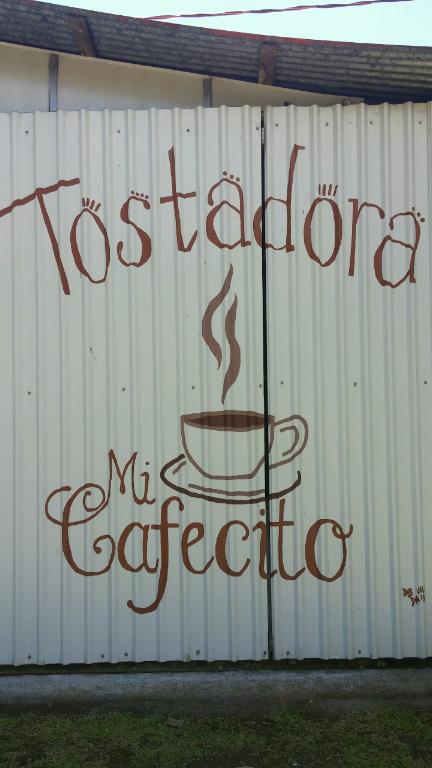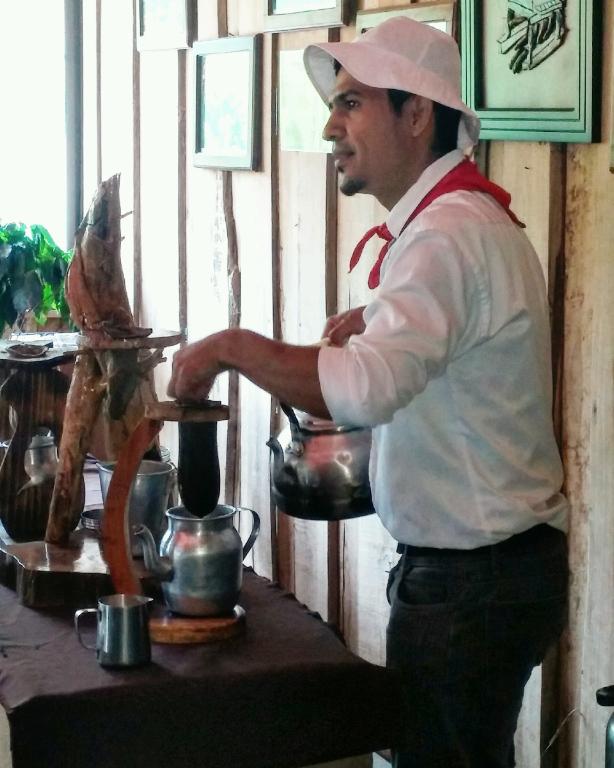We slowly begin to ascend and descend, ascend and descend through the mountains of Costa Rica. Early in our incline I can peer over to my right and see the city of San Jose begin to slowly decrease in its size while the valley vastly continues to gain depth. Making our way North from San Jose, we wind through the mountains and lush hillsides of country roads. Small towns reside in various places, rivers and valleys carve their way through the open foliage and fauna. Passing the beautiful Lapaz waterfall we take a short break from our transit to take in the details of the gushing waters. Small street vendors rest nearby to sell simple artifacts. No one here is pressing to sell you merchandise in Costa Rica. It is quite refreshing opposed to other countries. The sun is burning comfortably and the spotted clouds vary amongst the hillsides. Passing cows, banks, dogs, homes, deserted cars, bus stops, and coffee fields. We are on our way to La Fortuna.
Shortly enough we arrive at a coffee plantation. Mi Cafecito is the name. Our guide shows us the entire coffee producing process. From the first sow of seeds to the final packaging of beans. All the while during the tour, birds jolt from one nest to another high in the trees, squirrels practically as big as a golfer scale the trees amongst our coffee bean demonstrations. As this is their off-season, the machinery, after the picking of the beans, was nonoperational. Since this is their slow season, the tourism to the coffee plantation helps to even out the means of the company. Supplying earnings for wages, equipment, production and sustainability, Mi Cafecito stays afloat ad functional all year round. All the money we bring to the plantation goes directly back into the local environment and not to outsider companies.
After being shown the roasting and packaging of beans, we wandered our way to a small covering over a hand cranked machine. Our guide wanted to demonstrate how to release the juice from sugar cane. I volunteered to do the job. I muscled my way through hand cranking the sugar cane. Once most of the juices were expelled, the cane was bent in half and I forced the splintered cane through the crank once more. I drank my spoils with familiarity remembering when I would head to the Medina in Morocco to grab a small cup of fresh machine pressed sugar cane.
Our tour was ended in a display of hand-brewed coffee and a lovely lunch where casual discussion is encouraged. I utilized this time to ask more questions about the coffee plantation. Such as learning about where the beans come from since they don’t consist of an onsite plantation. Whether or not the local suppliers try to hustle the system and how. Wondering how the tourism impacts the livelihood and production directly. Since Costa Rica cannot compete with the various types of coffee all around the world such as Brazil, They stick to one type of coffee. This Arabica coffee is only grown in Costa Rica for production. As Costa Rica makes the best of this type of coffee bean they are not competed with in a sense. First grade quality is exported for sale and used throughout Costa Rica while second grade beans are shipped elsewhere.
This was a wonderful and unique experience. With Gadventures help and then Planeterra project, rest assured tourist money is put back into the local culture.





